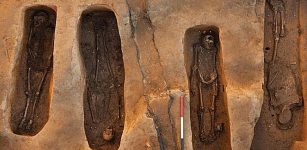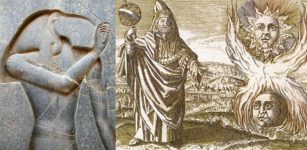Why Have The Leibniz Keks 52 Teeth And Are Named After Philosopher Gottfried Wilhelm Leibniz?
Conny Waters - AncientPages.com - The Leibniz-Keks remain now as popular as ever. Most have tasted these delicious butter biscuits found in almost every modern supermarket.
The production of the Leibniz-Keks started in 1891, and today, we can enjoy the original Butterkeks, but there are also several varieties of biscuits these days. The keks delight all chocolate lovers or anyone who can't resist a tasty biscuit.
But why do the Leibniz-Keks have 52 teeth, and why are they named after philosopher Gottfried Wilhelm Leibniz?
Left: Leibniz-Keks. Credit: Publix Domain - Right: Gottfried Wilhelm Leibniz. Credit: Publix Domain
Every cake or biscuit has its history, and the story of the Leibniz-Keks started in Queen Victoria's England when Hermann Bahlsen (1859-1919) worked as a sugar trader there. Bahlsen decided he wanted to produce his unique biscuit, so he did. He traveled to Hannover in Germany, founded the Hannoversche Keksfabrik, and started the production of the Liebnitz-Keks. Bahlsen's biscuit rivaled a similar French biscuit, the Petit-Beurre.
Initially, the name of Bahlsen was Leibniz Butter-Cakes, but very few people in Germany understood English, and German customers regularly mispronounced "Cakes "(as "Ka-kes "). So he changed the name to Leibniz-Keks.
When mentioning the name, we automatically think of philosopher Gottfried Wilhelm Leibniz (1646 -1716). It's widespread to name foods after famous personalities. For example, the Garibaldi biscuit, which consists of two soft rectangular slabs of biscuits sandwiched in a bed of currants, is named after Giuseppe Garibaldi, Italy's military leader and folk hero.
It is because "during the time Garibaldi spent in Britain, he became a celebrity. It is said the country shut down for three days when Garibaldi visited London in 1864. Higher and lower-class people received him, except for Queen Victoria and the royal family. One could find prints and busts of him in many Victorian homes.
His name was well-known and so popular that 1861 a new biscuit was made in his honor – the Garibaldi biscuit." 1
The prominent German polymath Gottfried Wilhelm Leibniz has very little in common with the popular biscuit Bahlsen started to produce.
Historians have tried to find a connection between the Leibniz-Keks and the biscuits, but frankly, there isn't one. The only thing these two have in common is that philosopher Leibnitz was born in Hannover, the same city where Bahlsen started the production of the biscuits. Who knows, maybe Bahlse admired the German philosopher's works?
Why Have The Leibnitz-Keks 52 Teeth?
What makes the Leibnitz-Keks unique and famous, except for the taste, is that each biscuit has 52 teeth. You may never have thought about it and perhaps not even bothered to count them, but next time, look closer, and you can see the butter biscuit has 52 teeth. Why is that, one can wonder?
There is no particular history behind this number. The shortbread biscuit has 52 teeth for purely aesthetic reasons. Bahlsen thought the teeth gave the biscuit a more attractive appearance.
The Choco Leibniz you often see in the shop is a crisp butter biscuit of our Choco Leibniz, dating back to 1889. It is coated in a layer of sumptuous, creamy chocolate. Currently, the company offers various biscuits with milk, dark, or orange-flavored milk chocolate. You might have guessed already – no matter what taste, all varieties of the Leibnitz-Keks have 52 teeth.
Written by Conny Waters – AncientPages.com Staff Writer
Updated on January 4, 2024
Copyright © AncientPages.com All rights reserved. This material may not be published, broadcast, rewritten or redistributed in whole or part without the express written permission of AncientPages.com
Expand for referencesMore From Ancient Pages
-
 Secrets Of Benjamin Franklin’s Paper Money Deciphered By Scientists
Archaeology | Jul 18, 2023
Secrets Of Benjamin Franklin’s Paper Money Deciphered By Scientists
Archaeology | Jul 18, 2023 -
 Unique Find In A French Crypt Offers The First Evidence Of European Familial Embalming Dating Back To The 16th Century
Archaeology | Nov 20, 2024
Unique Find In A French Crypt Offers The First Evidence Of European Familial Embalming Dating Back To The 16th Century
Archaeology | Nov 20, 2024 -
 3,600-Year-Old Bronze Dagger Made By The Minoan Civilization Found On Ancient Shipwreck
Archaeology | Sep 13, 2024
3,600-Year-Old Bronze Dagger Made By The Minoan Civilization Found On Ancient Shipwreck
Archaeology | Sep 13, 2024 -
 Evidence Reveals Ancient Saudi Arabia Had A Complex, Thriving Society, Contradicting Notions Of A Struggling Population In Barren Lands
Featured Stories | Aug 21, 2024
Evidence Reveals Ancient Saudi Arabia Had A Complex, Thriving Society, Contradicting Notions Of A Struggling Population In Barren Lands
Featured Stories | Aug 21, 2024 -
 1,500-Year-Old Inscription ‘Christ, Born Of Mary’ Engraved On Magnificent Building Discovered In Israel
Archaeology | Jan 21, 2021
1,500-Year-Old Inscription ‘Christ, Born Of Mary’ Engraved On Magnificent Building Discovered In Israel
Archaeology | Jan 21, 2021 -
 Tomography And Radiocarbon Dating Used To Examine Australian Aboriginal Knife
Archaeology | Jul 3, 2023
Tomography And Radiocarbon Dating Used To Examine Australian Aboriginal Knife
Archaeology | Jul 3, 2023 -
 Jamestown: Unearthed graves with four bodies and a small sealed silver box
News | Aug 28, 2015
Jamestown: Unearthed graves with four bodies and a small sealed silver box
News | Aug 28, 2015 -
 Mystery Of Famous Viking Ruler Rollo: DNA Experts Seek The Truth About His Identity
Featured Stories | Mar 16, 2016
Mystery Of Famous Viking Ruler Rollo: DNA Experts Seek The Truth About His Identity
Featured Stories | Mar 16, 2016 -
 The Aztec Sun Stone And Medusa Reveal An Intriguing Connection – Surprising Discovery – Part 1
Aztec Mythology | Jul 30, 2018
The Aztec Sun Stone And Medusa Reveal An Intriguing Connection – Surprising Discovery – Part 1
Aztec Mythology | Jul 30, 2018 -
 Spectacular Discovery – Scientists Decipher Previously Invisible Texts In Ancient Manuscripts
News | Nov 16, 2013
Spectacular Discovery – Scientists Decipher Previously Invisible Texts In Ancient Manuscripts
News | Nov 16, 2013 -
 Curse Of Evil Eye: Powerful Ancient Belief That Still Frightens People Around The World
Featured Stories | May 9, 2017
Curse Of Evil Eye: Powerful Ancient Belief That Still Frightens People Around The World
Featured Stories | May 9, 2017 -
 Ravana: Ten-Headed And Multi-Armed Demon King Of Lanka And Chief Antagonist In Epic Ramayana
Featured Stories | Oct 8, 2019
Ravana: Ten-Headed And Multi-Armed Demon King Of Lanka And Chief Antagonist In Epic Ramayana
Featured Stories | Oct 8, 2019 -
 Hermes Trismegistus Brought Divine Wisdom To Mankind – Secret Knowledge Of Hermetica
Featured Stories | Jan 17, 2019
Hermes Trismegistus Brought Divine Wisdom To Mankind – Secret Knowledge Of Hermetica
Featured Stories | Jan 17, 2019 -
 Striking Ancient Stone Idols: The Forgotten Polovtsian Statues Of Eastern Europe
Featured Stories | Mar 8, 2014
Striking Ancient Stone Idols: The Forgotten Polovtsian Statues Of Eastern Europe
Featured Stories | Mar 8, 2014 -
 Yak Milk Consumption Among Mongol Empire Elites – New Study
Archaeology | Apr 1, 2023
Yak Milk Consumption Among Mongol Empire Elites – New Study
Archaeology | Apr 1, 2023 -
 New Study Sheds Light On The Phenomenon Of Female Jewish Slavery And Uncovers Gang Rape In Livorno’s Slave Prison
Archaeology | May 18, 2022
New Study Sheds Light On The Phenomenon Of Female Jewish Slavery And Uncovers Gang Rape In Livorno’s Slave Prison
Archaeology | May 18, 2022 -
 Incredible Trove Of 100,000 Ancient Coins Tied Together In Bundles Uncovered In Japan
Archaeology | Nov 13, 2023
Incredible Trove Of 100,000 Ancient Coins Tied Together In Bundles Uncovered In Japan
Archaeology | Nov 13, 2023 -
 Wreck Of Historic Royal Ship ‘Gloucester’ Discovered Off The English Coast
Archaeology | Jun 10, 2022
Wreck Of Historic Royal Ship ‘Gloucester’ Discovered Off The English Coast
Archaeology | Jun 10, 2022 -
 The Battle Of Anghiari – Lost Painting Of Leonardo Da Vinci – One Of Art History’s Greatest Mysteries
Artifacts | Jan 24, 2018
The Battle Of Anghiari – Lost Painting Of Leonardo Da Vinci – One Of Art History’s Greatest Mysteries
Artifacts | Jan 24, 2018 -
 Ancient Liangzhu Culture Collapsed Due To Climate Change – New Study Says
Archaeology | Nov 25, 2021
Ancient Liangzhu Culture Collapsed Due To Climate Change – New Study Says
Archaeology | Nov 25, 2021

